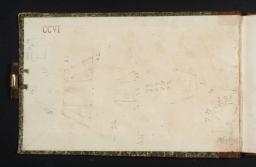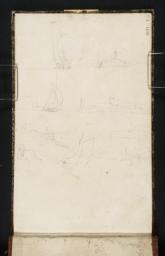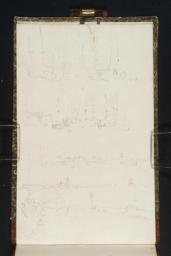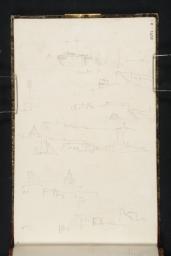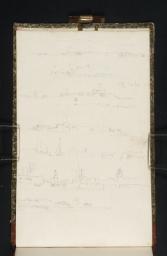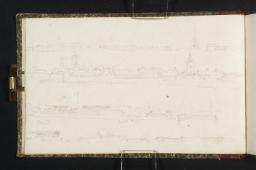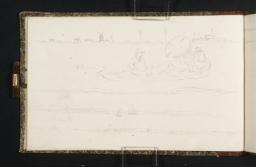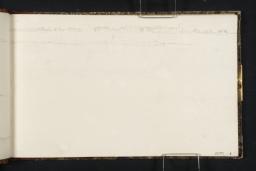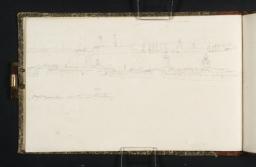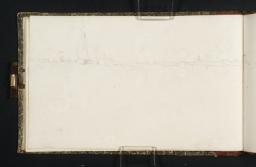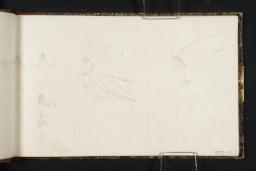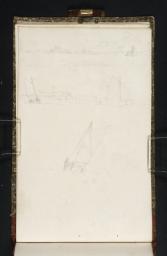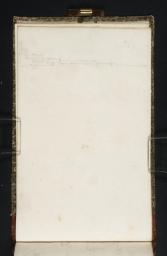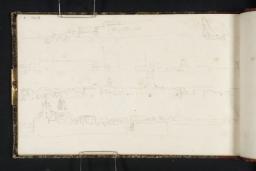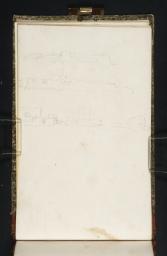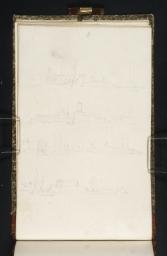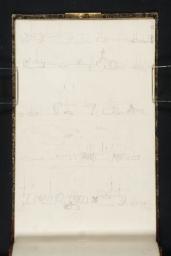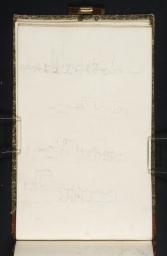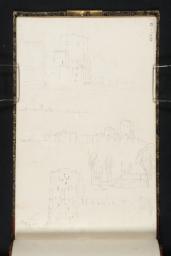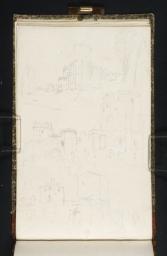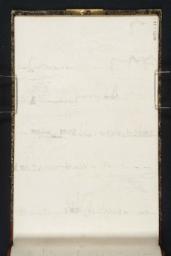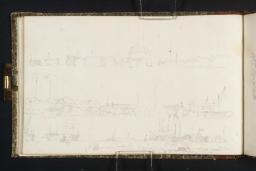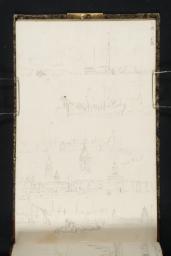Turner Bequest CCVI 1–42a
Sketchbook bound in boards, covered in grey marbled paper quarter-bound over brown leather spine; one brass clasp
42 leaves and paste-downs of white wove paper, page size 100 x 160 mm
Various leaves watermarked ‘1821’ and partially with ‘lls | 1’ and ‘ells | 21’
Numbered 370 as part of the Turner Schedule in 1854 and endorsed by the Executors of the Turner Bequest, inside back cover (D40968)
Stamped in black ‘CCVI’ on front cover, top right
42 leaves and paste-downs of white wove paper, page size 100 x 160 mm
Various leaves watermarked ‘1821’ and partially with ‘lls | 1’ and ‘ells | 21’
Numbered 370 as part of the Turner Schedule in 1854 and endorsed by the Executors of the Turner Bequest, inside back cover (D40968)
Stamped in black ‘CCVI’ on front cover, top right
Accepted by the nation as part of the Turner Bequest 1856
References
This sketchbook is divided about equally and distinctly between two subjects: firstly, the harbour and major Royal Navy base at Portsmouth in Hampshire; secondly, a pageant on the River Thames in central London. While the Portsmouth sketches yielded watercolours for engraving projects, the London subject was left undeveloped. A few pages at the end (folios 40 recto–42 verso and the inside of the back cover; D17986–D17990, D40968) comprise miscellaneous sketches including views on the Thames at Isleworth and Chiswick.
A continuous series of views around Portsmouth and Gosport runs between folios 1 recto and 20 recto (D17913–D17951). About halfway through these there was also an excursion of about three miles across the wide natural expanse of Portsmouth Harbour, to the ancient Portchester Castle on its north side (folios 11 verso, and 12 recto and verso; D17934–D17936). Otherwise, Turner’s Portsmouth studies in the present book appear to have been made from a boat offshore. They show the defences at Gosport on the west side of the harbour entrance, and Portsmouth itself on the east, running north to the dockyards which survive today as the Historic Dockyard complex, home to Nelson’s flagship HMS Victory (see ‘Marine Subjects c.1803–14’ in the present catalogue), the iron-clad HMS Warrior, and the museum displaying the remains of Henry VIII’s flagship the Mary Rose, south of the still operational Royal Navy base. The date of the visit was perhaps the summer of 1824, when Turner is thought to have toured East Anglia and the South Coast, using the Brighton and Arundel sketchbook (Tate; Turner Bequest CCX) for subjects not far from Portsmouth.1
Three watercolours followed, showing similar views from Spithead, the area of sea between Portsmouth and the Isle of Wight, looking north through the harbour entrance, with Gosport on the left and Portsmouth on the right and beyond. Portsmouth, of about 1824 (Lady Lever Art Galley, Port Sunlight),2 was engraved in 1825 for Picturesque Views on the Southern Coast of England (Tate impressions: T04419, T05302–T05304, T05994). Another Portsmouth, of about 1824–5 (Tate D18152; Turner Bequest CCVIII S),3 was engraved in 1828 for The Ports of England, and reissued in 1856 in The Harbours of England (Tate impressions: T04833, T04834); see also the colour study, Tate D17758 (Turner Bequest CCIII A). Lastly, Gosport, Entrance to Portsmouth Harbour, of about 1829 (Portsmouth Museums and Records),4 was engraved in 1831 for the Picturesque Views in England and Wales (Tate impressions: T04574, T04575). In each, large warships are seen at anchor in the distance, with various ships and boats manoeuvring in heavy seas in the foreground. The Southern Coast composition gives equal space to Gosport and Portsmouth in the middle distance, with the channel between them roughly at the centre of the composition; in the Ports view Turner focused on the right-hand two thirds of this prospect, with Gosport only just within view, while in the England and Wales view the opposite is the case, with the Gosport fortifications taking up the left half while little of Portsmouth is shown.
Although Portsmouth suffered severe bombing in the Second World War (see Richard Eurich’s 1941 painting Night Raid on Portsmouth Docks, Tate N05690), and has seen much redevelopment and growth since Turner’s time, the basic layout of the massive fortifications and docks he recorded survives, along with several prominent landmarks which appear repeatedly in this sketchbook. On the High Street in Old Portsmouth, just inland from the bastions and sea wall on the east side of the harbour entrance, stands Portsmouth Cathedral, with its square central tower topped by a Baroque cupola, dome and lantern. Beside the water to its south-west is the 1494 Square Tower, effectively a small fort, upon which the wooden Admiralty semaphore station tower Turner drew stood between 1822 and 1848, when telegraphy had made it redundant.5 There appears to be a sequence of semaphore signals shown on folio 36 recto (D17982).
Projecting into the sea south-east of the Square Tower is the Saluting Platform, while a little to its north-west is the Round Tower of 1418–20, which had been raised in height in 1815 (and would be again in 1850), with the 1680s Eighteen Gun Battery beside it.6 The tall, four-square tower in various sketches marks Baltic Wharf near the Round Tower, built in 1814 by a banker named Burridge; the venture was unsuccessful, being dubbed ‘Burridge’s folly’, and burned down in 1865.7 A little to the north, facing the harbour off Gunwharf Road, is the Vulcan Block, or Building 21, an 1814 ordnance storehouse comprising a central range with a clock tower and wings projecting towards the waterfront;8 it is now apartments. Just to its north is Portsmouth’s most prominent modern landmark, the white, sail-like Spinnaker Tower.
In the Royal Navy Dockyard views, attention focuses on storehouses built between 1760 and 1790, centred on No.10 Store with its cupola clock tower, destroyed in the bombing of 1941 as depicted in Eurich’s painting, and replaced by a replica in 1992.9 Just to its south-west is the Semaphore Tower; shown in the distance in the Southern Coast and Ports designs, it was destroyed by fire in 1913 and rebuilt in a modified form, and now houses the offices of the Naval Base Commander and the Queen’s Harbour Master.10 Returning to the harbour entrance, opposite the Round Tower on the Gosport side the most prominent feature is the long, low blockhouse with lunette openings for ordnance on the south-facing sea side, which remains recognisable.
Among studies of shipping, the Spithead sketchbook of 1807 had contained only one slight drawing of towers at Portsmouth (Tate D06521; Turner Bequest C 4), while the oil painting Spithead: Two Captured Danish Ships Entering Portsmouth Harbour of 1807–9 (Tate N00481; also known as ‘Spithead: Boat's Crew Recovering an Anchor’)11 is a sea view. See also the watercolour, perhaps of a similar date to the present sketchbook, traditionally know as Plymouth Harbour: Towing in French Prizes,12 but proposed by Robert Upstone as showing rather ‘Portsmouth Harbour: The Entry of French Prizes’, since the Saluting Platform appears to be shown in the foreground.13
The Review at Portsmouth sketchbook of 1814 includes several views from the sea (D10012, D10013, D10031, D10032, D10055, D10062, D10074, D10128; Turner Bequest CXXVI 24a, 25, 42, 43, 61a, 65, 75a, 124), comparable with those in the present book. There are studies of the Victory moored at Portsmouth and a busy quay scene in the 1827 Isle of Wight sketchbook (Tate D20766, D20768; Turner Bequest CCXXVII 22, 23). Otherwise, Turner does not seem to have returned until 1844, when the French king (an old acquaintance of Turner’s) arrived by steamer, as recorded in drawings such as Tate D34961 and D35899 (Turner Bequest CCCXLIV 458, CCCLXIV 57) and The Arrival of Louis-Philippe at Portsmouth, 8 October 1844 (Tate N02068)14 and The Disembarkation of Louis-Philippe at the Royal Clarence Dockyard, Gosport, 8 October 1844 (Tate N04660)15 two hazy, unfinished oil paintings identified as showing the subject only in recent years. In the intervening two decades, at least in his oils, Turner had effectively abandoned the concern for topographical accuracy which had driven him to fill so many sketchbooks with detailed studies of sites such as Portsmouth.
Following his likely summer visit to Portsmouth and several intervening weeks in Belgium, Luxembourg, Germany and northern France, the record of Turner’s whereabouts in the autumn of 1824 is limited to a letter from him dated 21 September, presumably sent from London,16 and a diary entry by Mrs Walter Fawkes concerning his arrival at Farnley Hall in Yorkshire on 19 November.17 On 9 November, the regular annual date, there was a particularly spectacular Lord Mayor’s Day, involving the traditional river pageant along the Thames to the Palace of Westminster for a swearing-in ceremony. David Hill has mentioned this event in passing in relation to the likely dating of the London views in the present sketchbook, given the state of building work on the replacement for Old London Bridge just upstream, particularly in terms of piledriving operations to secure the coffer-dams facilitating work on the new structure’s piers. In the Old London Bridge sketchbook (see in particular Tate D17845–D17846; Turner Bequest CCV 6a–7), this process seems ‘to be at an early stage, suggesting a date during the summer of 1824. The same piling operations appear at a slightly more advanced stage of development in sketches in the London Bridge and Portsmouth sketchbook’ (see folios 21 verso–22 recto; D17953–D17954), suggesting a date slightly later in the year, perhaps in the autumn.’18
The equivalent ceremonies in 1823 and 1825 were reported quite briefly,19 but the 1824 event seems to have been of a different order. The Morning Post of 6 November anticipated the occasion:
The restoration of many almost forgotten characters in the Show, will render it a general object of curiosity to all who have not seen it a hundred times. Whifflers, javelin-men, masters of defence, &c. will lengthen the procession, and some idea of its extent may be formed, by the fact, that the Goldsmiths’ Company (that of the Lord Mayor elect) who have not had the honour of seeing one of their livery in the civic chair for twenty years, have with their usual splendid liberality prepared in honour of their craft a walking procession that will extend from Guildhall to Bow Church. And for the aquatic excursion, their new Barge has been decorated with a degree of magnificence seldom witnessed. It is said the whole procession will pass over Blackfriars and embark on the Surrey-side of the Bridge. The band of the Guards has been engaged instead of that of the East India Company which generally has been employed upon these occasions; in short, no exertion or expense has been spared to render this ancient ceremony worthy of the first City of the Kingdom.
Lengthy pieces in The Times, and The Morning Post and The Morning Chronicle of 10 November confirmed that the procession had indeed been magnificent; of the waterborne phase, The Times reported:
At Blackfriars-bridge, where the crowds of spectators were immense, the company embarked on board the city state barge. The barges of the Goldsmiths’, the Merchant Tailors’, the Fishmongers’, the Grocers’, and several other companies received the suite. All the barges were decorated with the emblazoned banners of the companies, and were unusually brilliant upon the water. The wind was rather brisk, and near Waterloo-bridge the Goldsmiths’ barge, in spite of the exertions of the watermen, was driven against one of the heavy coal barges, and sustained some damage. Near Blackfriars-bridge, several persons tumbled into the water, but we are glad to say no serious accident occurred – an extraordinary fact, considering that such a crowd of small boats accompanied the aquatic pageant, that it was a matter of great difficulty to avoid upsetting some of them. The Lord Mayor was saluted by repeated discharges of cannon, and the ringing of all the city bells.
The new Lord Mayor, John Garratt, appears to have had a particular liking for grand occasions, as on 15 June the following year he laid the foundation stone of the new London Bridge in an elaborate ceremony on the bed of the river within one of the coffer-dams; from numerous drawings in the Mortlake and Pulborough sketchbook (Tate; Turner Bequest CCXIII) Turner appears to have been present then too. Given the advance publicity, the artist presumably made it his business to be on hand for the November festivities, no doubt rich in pictorial possibilities, as exploited in the 1830 watercolour of The Lord Mayor’s Show at Westminster by David Roberts (1796–1864; Guildhall Art Gallery, London), showing ornate City barges off Westminster Hall. If Turner had thought to produce such a work, it came to nothing. Nevertheless, the drawings between folios 20 verso and 34 verso (D40967, D17979) include rapid studies and notes of the barges, flags, costumes and bridges along the route. Folio 26 verso (D17963) shows figures on horseback; see the entry for further discussion.
Turner had made a detailed study of the Lord Mayor’s barge in his 1805 Studies for Pictures: Isleworth sketchbook (Tate D05518; Turner Bequest XC 20), which seems to have set him thinking of historical precedents, depicting Antony and Cleopatra afloat on another page (Tate D05617; Turner Bequest XC 84a). He sketched the Skinners’ Company barge in the Hints River sketchbook of about 1815–18 (Tate D10588–D10589; Turner Bequest CXLI 1a–2), and showed City barges in his Thames paintings England: Richmond Hill, on the Prince Regent’s Birthday (Tate N00502),20 exhibited in 1819, and Mortlake Terrace, the Seat of William Moffatt, Esq. Summer’s Evening, shown in 1827 (National Gallery of Art, Washington, DC).21
Because the dating of some of its contents is likely but not certain, an overall date of ‘c.1824’ has been applied to the present sketchbook. Finberg noted ‘No label on back’22 of the sort which sometimes survives, numbered and titled in ink on a white wove paper label pasted onto the spine. He recorded John Ruskin’s comments on a wrapper, since lost, as ‘370. Small ships at Gosport. Of interest, but small value.’23 In the absence of any general inscription by Turner, the present title of the book was presumably assigned by Finberg on the evidence of the contents, rather than adapting the wording of Ruskin’s label.
See Alexander J. Finberg, The Life of J.M.W. Turner, R.A. Second Edition, Revised, with a Supplement, by Hilda F. Finberg, revised ed., Oxford 1961, p.285.
Ibid., p.397 no.828, reproduced; for the work in context, see James Hamilton, Our Roaring Channels: Turner, Portsmouth and the Sea, Portsmouth 2002.
See ‘The Square Tower’, Portsmouth Museums and Records, accessed 12 December 2014, http://www.portsmouthmuseums.co.uk/museum-service/The-Square-Tower ; see also ‘The History of the Square Tower’, The Square Tower, accessed 12 December 2014, http://www.squaretower.co.uk/square_tower_history.html , dating the semaphore to 1823.
See ‘The Round Tower’, Portsmouth Museums and Records, accessed 12 December 2014, http://www.portsmouthmuseums.co.uk/museum-service/The-Round-Tower .
See John Sadden, The Portsmouth Book of Days, ebook ed., Stroud 2012, unpaginated, under ‘May 26th’.
See ‘Vulcan Block (Building Number 21) and Attached Bollards, Portsmouth’, British Listed Buildings, accessed 16 December 2014, http://www.britishlistedbuildings.co.uk/en-474696-vulcan-block-building-number-21-and-atta .
See ‘Historic Landmarks: Great Naval Storehouses’, Portsmouth Historic Dockyard, accessed 12 December 2014, http://www.historicdockyard.co.uk/dockyardlandmarks/ .
Martin Butlin and Evelyn Joll, The Paintings of J.M.W. Turner, revised ed., New Haven and London 1984, pp.60–1 no.80, pl.90 (colour).
See Robert Upstone, ‘Picture Note 1’, Turner Studies, vol.10, no.1, Summer 1990, pp.54–5, reproduced.
Butlin and Joll 1984, p.297 no.505, pl.506 (colour), as ‘Procession of Boats with Distant Smoke, Venice’, c.1845.
See John Gage, Collected Correspondence of J.M.W. Turner with an Early Diary and a Memoir by George Jones, Oxford 1980, p.93 letter no.106.
Technical notes
How to cite
Matthew Imms, ‘London Bridge and Portsmouth Sketchbook c.1824’, sketchbook, December 2014, in David Blayney Brown (ed.), J.M.W. Turner: Sketchbooks, Drawings and Watercolours, Tate Research Publication, April 2015, https://www

